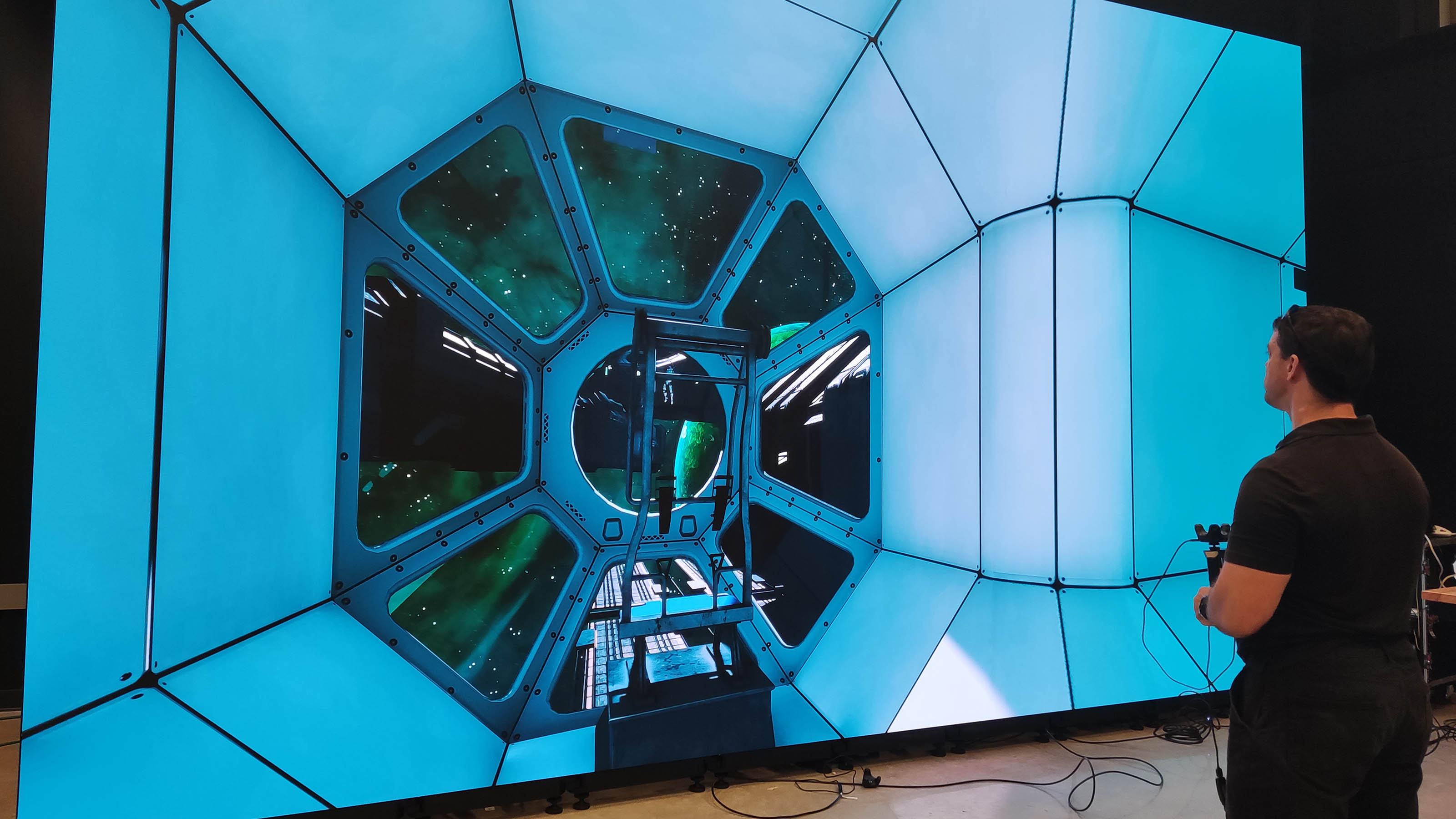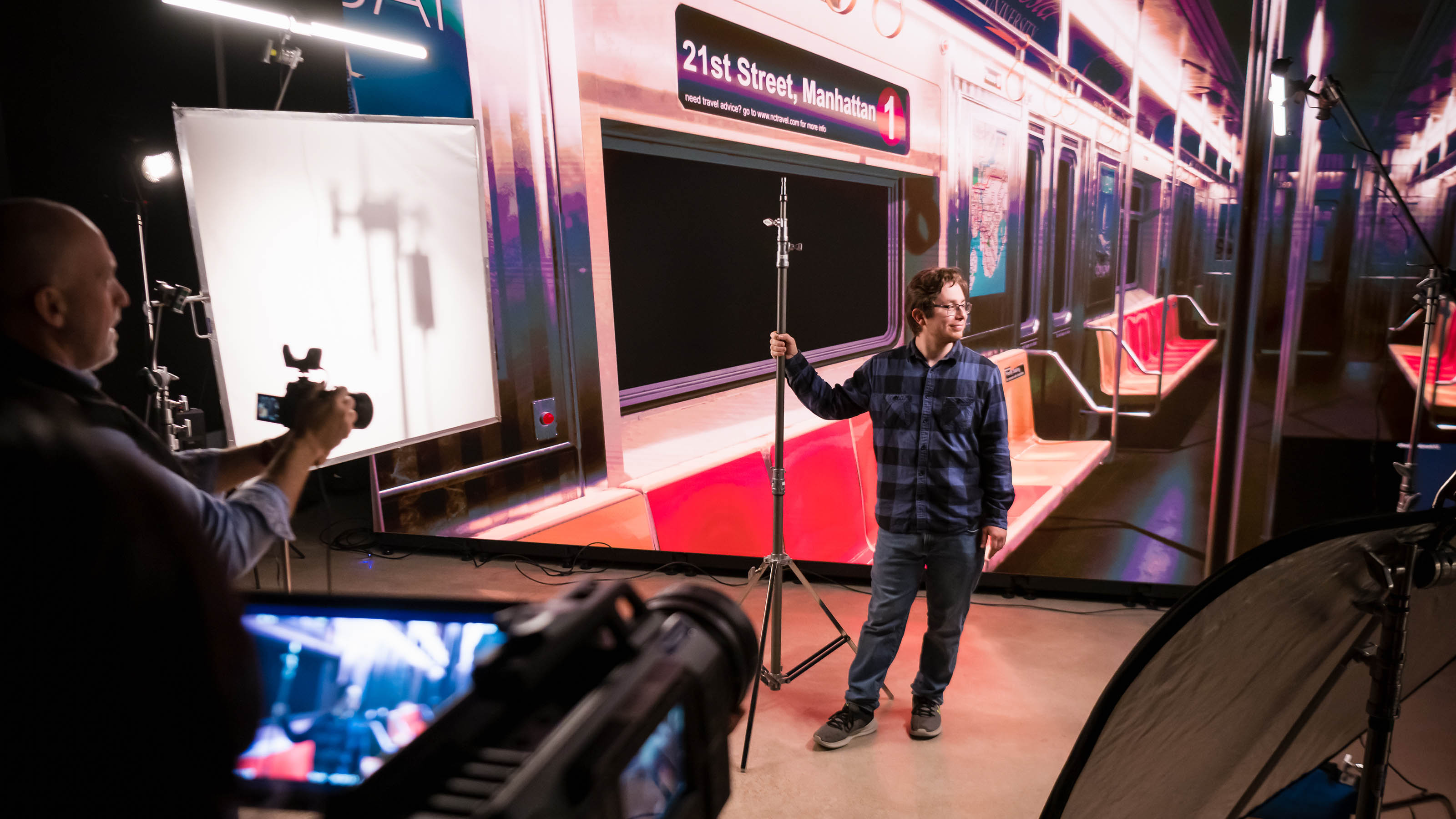
In Fall 2022, Webster University in St. Louis deployed a virtual production (VP) stage in its School of Communications. Working with LED wall manufacturer Absen and XR company ARwall, the university integrated a 20x12-foot, 1.5mm pixel pitch Absen AX Pro LED wall and ARwall ARFX Pro Server System.
[Explore Faraway Lands…in Atlanta]

Webster's School of Communications offers 15 different undergraduate majors as well as a media production program that enables students to combine a number of disciplines for a more diversified degree, According to Eric Rothenbuhler, dean, the School of Communications also operates an internship office internally, allowing students to produce projects for external customers.
“Our curriculum is built on integrating theory and practice, so our students have their hands on equipment the second week of their freshman year,” Rothenbuhler said. “We bring client work into classes, so students have experience with real budgets, real deadlines, real clients. It’s a hands-on curriculum, and we take pride in the quality of the facility and the equipment.”
Head of the Class

The virtual production stage is part of the second phase of a remodeling project that involves the school’s entire 66,000-square-foot Sverdrup Building. Rothenbuhler said the main driver behind the VP stage deployment was the school’s goal to be on the forefront of media production technology.
“Right now, the most famous applications are for The Mandalorian and some other major studio productions, but think about smaller television and video production, [such as] corporate events, conventions, or producing a TV commercial,” Rothenbuhler offered. Instead of closing down a major fast food chain restaurant, for example, producers can now create a virtual dining room in a studio. Filmmakers who need a sunrise scene can shoot whenever they want, not just when the sun is rising.

Brian Macauto, director of virtual production at Absen, said the company's AX Pro LED wall includes several features that are well-suited for VP, including a high base refresh rate, accurate brightness, and precise color temperature levels. “In a normal LED application, none of these things really matter,” he said. “In the cinema world, when you’re editing your footage and you’ve gone from Shot A to Shot B and the red brick wall—the background—changes from red to orange, then you have to change it all in post production.”
[What You Missed at NAB 2023: Dave Van Hoy on VR Production, Cloud Technology]
ARwall’s on-set workstation includes its ARFX Pro Plugin, as well as the ARFX Launcher. The tools are powered by Unreal Engine 5, a real-time 3D creation platform. The ARFX Pro Plugin combines pre-visualization, production, and post in a single tool set. “Basically, you use the plugin to do the pre-vis and animatics, and you’re going to use those exact same bookmarks and presets to actually go and shoot your project,” explained Rene Amador, CEO and co-founder of ARwall.
Integration with Unreal Engine also simplifies the production process. “What we’ve done is [include] all the tools for virtual production in the actual engine—very much like a video game menu—so that you can change the color and the camera settings on the fly," Amador added.
Lights, Cameras, Pixels
Webster’s virtual production stage uses ARRI cameras. In applications like this, to ensure that the cameras play nice with the LED wall, Amador counsels a solid calibration system. As the physical camera moves, the virtual camera is “attached” to it at a 1:1 spatial ratio. “What that’s going to do is align the virtual camera to the physical camera so that they’re basically stuck together,” he said.

Pitch size is another important component of a VP environment. A tighter pixel density, such as the 1.5mm pitch of the LED wall at Webster, enables people to get closer to the screen. “If space is a consideration, then you will want to consider a tighter pitch screen so that you can avoid moiré effects,” Amador said.
At 1.5mm, actors can be 6 feet in front of the screen—and with the screen slightly defocused, moiré and pixelation aren’t a problem. “For those really shallow close-up shots," he observed, "it’s a good fit.”
Webster is utilizing its existing lighting rigs for its virtual production stage. But in general, Amador argued that directors of photography working in this type of environment will discover they need smaller lighting kits, since the LED screen is, itself, a source of light. ARwall recommends DMX or Artnet systems, which can be driven out of Unreal Engine.
Previously, shining light directly onto an LED backdrop produced too much glare. These days, this is rarely a problem, according to Amador. “The new LED panels that are being generated by our partners and by most of the industry have a low-reflectivity, low-glare matte finish on the black set portion of the screen,” he said. “At this point, you can shine a spotlight directly onto the screen as a hard key and you’re not going to run into too many issues.”
Don't Just Sit There
In order to achieve an acceptable ROI on this technology, Rothenbuhler said it was necessary to incorporate it into the school’s curriculum quickly. This means that both faculty and students must be excited about learning the new tech and using it for their projects. “The potential mistake is to spend a lot of money on the new technology and think that’s the end of the story, and the technology just sits there,” he said. “You have to have real classes that are really using it in their regular curriculum.”
“Instead of asking you to do it later, we’re basically giving you the power to do it right there. That’s the headline for virtual production."
Rene Amador, ARwall
The VP environment eliminates a lot of the post-production stress associated with traditional greenscreen technology, according to Amador, who has more than 350 commercials under his belt. On greenscreen shots, he said the director is not always 100 percent certain they got what they needed on set—and if they haven’t, they've got to fix it in the editing bay.
“There is a lot less uncertainty,” he said. “Instead of asking you to do it later, we’re basically giving you the power to do it right there. It reduces some of the tension on set. That’s the headline for virtual production.”
VP Opps for Integrators
While large-scale studio projects get the most press, virtual production (VP) presents plenty of opportunities for other markets. Brian Macauto, director of virtual production at Absen, noted that higher education and corporate applications can also benefit from this technology.
[Viewpoint: How Fast is the Pace of Technological Progress?]
At the same time, VP remains a highly specialized field, one that is unfamiliar to many traditional Pro AV integrators. Macauto said employing a full-time specialist is probably cost-prohibitive. For integration firms that are seeking to expand into this area, he suggested they partner with reputable VFX firms.
“The stopgap solution right now—before XR and VP become mainstream types of projects—is to bring in a third-party consultant who has that experience as a subcontractor to the integration company,” Macauto said. “They will be paid as a consultant to do the design work, and then the integration company basically takes over the installation part. They could even bring in the consulting company to commission and program the system.”







